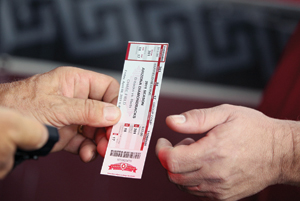NCAA Division I-A sports generated an estimated $4.1 billion in revenue in 2009, a 60 percent increase in revenue in just five years. With an increase in business, however, comes an increased number of counterfeiters looking to capitalize on the valuable intellectual property rights of colleges and universities.
Counterfeiting is not a new phenomenon in the sports world or otherwise. Many industries face the perils of counterfeiting, from entertainment to consumer electronics to pharmaceuticals. Counterfeiting not only has an impact on a business’s bottom line, but it also affects the good will of the brand and the reputation of the brand owner.
Colleges and universities face counterfeiting issues on several fronts, most prominently with tickets and merchandise. Counterfeit tickets have been an issue in college sports for decades. Articles and news stories discussing counterfeit tickets reveal a concerning, yet expected, trend: The higher profile the game, the greater the risk for counterfeiting and the higher the price some unfortunate fans pay for counterfeit tickets. For example, before the 2011 BCS national championship game, Phoenix police seized more than 200 counterfeit tickets with a face value of $60,000 — and a street value closer to $600,000 — from a single counterfeiting ring.
The International Chamber of Commerce believes that counterfeiting has flourished over the last several decades largely due to four factors:
1. The profitability of counterfeiting.
2. The absence or inadequacy of intellectual property laws in many countries.
3. The availability of cheap equipment to facilitate copying.
4. The perception that counterfeiting is a low-grade, harmless crime.
 |
GETTY IMAGES
Educating fans about reliable sources for purchasing tickets should be part of a team’s action plan. |
Whatever the reason, colleges and universities can no longer take a backseat approach in dealing with counterfeiting. Instead, colleges and universities can combat the proliferation of counterfeiting by developing a consistent and comprehensive plan.
The first step is to establish an internal team to deal with counterfeiting. The composition of the team may include in-house lawyers, general counsel, outside IP counsel, private investigators and/or paralegals. Institutions should also consider appointing an anti-counterfeiting specialist.
Once a team is established, it is important to develop an action plan, which may include some or all of the following strategies:
• Categorize counterfeiting activities. Create categories from low risk to high risk and use consistent strategies to deal with counterfeiters based on the category of risk.
• Shore up all intellectual property rights. Make sure all indicia are adequately protected from a trademark and copyright perspective, both on a national and a global scale. The purpose of obtaining federal protection for all indicia is twofold: (a) federal and foreign protection gives institutions statutory options for pursuing counterfeiters; and (b) institutions can record federal trademark and copyright registrations with U.S. Customs and Border Protection that then can be used to stop counterfeit products at the border.
• Utilize appropriate legal channels for dealing with counterfeiting activity. The legal action taken will largely depend on the risk category. If, for example, you consider the counterfeiting activity to be relatively low risk, the first step may be to send a demand letter. For more severe cases, you may elect to file a civil and/or criminal action in order to stop the counterfeiting activity.
• Education is key. Educate employees, licensees, agents and others of the internal procedures for dealing with counterfeiting and train them to detect counterfeit products. Institutions should also educate fans on the importance of purchasing tickets directly from the ticket office or from other reliable sources. Some universities have set up verification booths outside stadiums where buyers and sellers can meet and ticket authenticity can be verified prior to purchase.
• Keep your finger on the pulse of the market. Monitor the marketplace online by appointing an employee to patrol websites popular among counterfeit sellers, such as eBay, Craigslist and ticket broker websites. Set up Google alerts to notify you when third parties are advertising the sale of tickets or authentic merchandise, or hire private investigators.
• Use the media. Issue press releases warning fans of counterfeit tickets and merchandise. This strategy is now routine for many colleges and universities, especially before conference championship games, bowl games and high-profile regular-season games.
• Technology is your friend. Counterfeiters continually look for the most advanced technology to create authentic-looking knockoffs. Therefore, colleges and universities must be one technological step ahead of the counterfeiters. Current anti-counterfeiting technologies include watermarks, micro-printing, holograms, magnetic strips, microscopic tags, and infrared visible and invisible inks. When addressing ticket counterfeiting, colleges and universities can also consider switching to paperless ticketing. A paperless system will require a ticket purchaser to present a credit card and ID to gain access to an event, which eliminates the threat of counterfeit tickets.
• Information is power. Create a database to track counterfeiting activities. This information is essential in developing a consistent and effective anti-counterfeiting strategy. For example, if the information gathered indicates that a particular product is being repeatedly counterfeit, use additional technological measures or to dedicate additional resources to combat the counterfeiting activity.
Counterfeiting not only seriously affects the bottom line of the country’s colleges and universities, but it also poses a risk to the underlying good will of the names and indicia of all colleges and universities. If colleges and universities do not yet have an anti-counterfeiting plan in place, these institutions would be wise to pull together a comprehensive plan using some or all of the strategies outlined here, and such a plan should then be continually updated to address the most recent advances in anti-counterfeiting techniques.
Emily Bayton (EBayton@LRLaw.com) is a partner and Nathaniel Edwards (NEdwards@LRLaw.com) is an associate in Lewis and Roca’s intellectual property and technology practice group.





